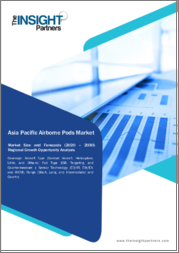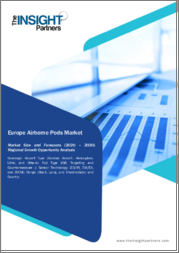
|
시장보고서
상품코드
1494542
아시아태평양의 항공기용 포드 시장 예측(-2030년) : 지역별 분석 - 항공기 유형, 포드 유형, 센서 기술, 거리별Asia Pacific Airborne Pods Market Forecast to 2030 - Regional Analysis - by Aircraft Type, Pod Type, Sensor Technology, and Range |
||||||
아시아태평양의 항공기용 포드 시장은 2022년 6억 1,608만 달러에서 2030년에는 10억 3,328만 달러로 성장할 것으로 예측되고 있습니다. 2022-2030년의 CAGR은 6.7%를 기록할 것으로 추정됩니다.
불안정한 지정학적 시나리오의 증가와 첨단 전쟁 기술의 출현이 아시아태평양의 항공기용 포드 시장을 촉진
세계의 지정학적 시나리오가 불안정해지면서 첨단 센서, 레이저 및 자기방어 대책 시스템에 대한 수요가 증가하고 있습니다. 국가 간 전쟁과 같은 불안정한 지정학적 현상은 일반 시민의 삶을 위험에 빠뜨리고 국가 안보 위협과 불확실성을 증가시키고 있습니다. 따라서 이러한 상황에 대응하기 위해 국방력 강화에 대한 관심이 높아지고 있습니다. 첨단 정보, 감시 및 표적 시스템은 완전하고 정확한 분석을 용이하게 하고 보다 정확한 위협 평가와 표적과의 만남을 돕습니다. 고급 전쟁 시나리오는 고급 상황 인식, 통합 방어 시스템, 표적과의 교전 개선, 전자전 능력, 진화하는 위협에 대한 대응을 강조합니다. 따라서 첨단 전장 상황에 대응하기 위한 항공기 포드 개발은 첨단 전장 장비 및 장비의 채택 증가로 인해 더욱 촉진되고 있습니다. 또한 전 세계 많은 기업이 현대 전쟁에 대응하기 위해 항공기용 포드 및 장비가 장착된 첨단 헬리콥터와 무인 항공기에 대한 투자에 집중하고 있습니다. 이처럼 불안정한 지정학적 시나리오의 사례 증가와 현대 전쟁 기술의 보급이 항공기 포드 시장을 주도하고 있습니다.
아시아태평양의 항공기용 포드 시장 개요
아시아태평양에서는 인도, 호주, 중국, 일본, 한국이 항공기용 포드의 주요 시장입니다. 국가 안보에 대한 관심 증가와 공군 안보 인프라를 강화하기 위한 정부 구상의 증가는 아시아태평양에서 항공기용 포드의 수요를 촉진하는 몇개의 요인입니다. 2020년 군비는 4,974억 달러로, 2021년에는 5,497억 달러로 증가했습니다. 2022년, 아시아태평양의 군비는 5,415억 달러였습니다. 2022년에는 중국이 이 지역의 군비 지출을 독식하고 인도와 한국이 그 뒤를 이었습니다. 군비의 대부분은 현대화 장비, 장비, 항공기, 선박, 장갑차 등 현대 전쟁에 필요한 현대화 장비, 장비, 항공기, 선박, 장갑차 등 현대 전쟁에 대응하는 데 사용됩니다. 각국은 최신 센서와 추적 장비를 장착한 새로운 고급 항공기로 군용 항공기를 진화시키는 한편, 오래된 항공기를 교체하는 데 주력하고 있습니다.
현대 전장의 요구에 부응하기 위해 해마다 더욱 정교하고 숙련된 장비와 항공기의 필요성이 증가하고 있습니다. 예를 들어 인민해방군 공군은 2023년 전투기 보유 대수를 늘릴 계획을 발표했습니다. 또한 공대공 미사일을 통합하고 고급 공대지 대지 대치 무기를 개발하여 중국의 방어력을 더욱 강화할 것이며, 2023년 한국항공우주산업은 KF-21 보라매 전투기 시제품을 도입하고 KAI 경무장 헬리콥터 개발을 추진했습니다. 공군은 2028년까지 40대의 KF-21을 조달하고 2032년까지 80대를 추가로 운용하는 데 중점을 둔 전략을 취할 것으로 예상됩니다.
2023년 아시아태평양의 군용 항공기 보유 대수는 11,646대에 달할 것으로 예상됩니다. 항공기용 포드는 전투기, 헬리콥터, 항공기에 잠재적인 용도가 있으며, 안정적인 공중 탐지, 인식, 추적, 식별, 이미지 캡처, 통신, 항법, 감시 및 대응을 용이하게 합니다. 전쟁과 같은 상황이 증가함에 따라 아시아태평양에서 항공기용 포드에 대한 수요가 증가하고 있습니다.
아시아태평양 항공기용 포드 시장 매출 및 2030년까지의 예측(금액)
아시아태평양의 항공기용 포드 시장 세분화
아시아태평양의 항공기용 포드 시장은 항공기 유형, 포드 유형, 센서 기술, 항속거리, 국가별로 구분됩니다.
항공기 유형에 따라 아시아태평양 항공기 포드 시장은 전투기, 헬리콥터, UAV 및 기타로 분류됩니다. 전투기 부문은 2022년 아시아태평양 항공기용 포드 시장에서 가장 큰 점유율을 차지했습니다.
포드 유형에 따라 아시아태평양 항공기용 포드 시장은 ISR, 타깃팅, 자기보호/대책으로 구분되며, ISR 부문은 2022년 아시아태평양 항공기용 포드 시장에서 가장 큰 점유율을 차지할 것으로 예상됩니다.
센서 기술을 기반으로 아시아태평양의 항공기용 포드 시장은 EOIR, EWEA, IRCM으로 구분되며, EOIR 부문은 2022년 아시아태평양의 항공기용 포드 시장에서 가장 큰 점유율을 차지했습니다.
항속거리 기준으로 아시아태평양의 항공기용 포드 시장은 단거리, 중거리, 장거리로 구분되며, 2022년 아시아태평양 항공기용 포드 시장에서 가장 큰 점유율을 차지하는 것은 장거리 부문입니다.
국가별로는 아시아태평양의 항공기 포드 시장은 호주, 중국, 인도, 일본, 한국, 기타 아시아태평양으로 구분되며, 2022년 아시아태평양의 항공기 포드 시장은 중국이 독주할 것입니다.
BAE Systems Plc, L3Harris Technologies Inc, Lockheed Martin Corp, Northrop Grumman Corp, Saab AB, Terma AS, Thales SA, Ultra-Electronics Holdings Ltd, Raytheon Technologies Corp는 아시아태평양의 항공기용 포드 시장에서 사업을 운영하고 있는 대기업입니다.
목차
제1장 서론
제2장 주요 요약
- 주요 인사이트
- 시장의 매력
제3장 조사 방법
- 조사 범위
- 2차 조사
- 1차 조사
제4장 아시아태평양의 항공기용 포드 시장 구도
- Porter의 산업 분석
- 에코시스템 분석
제5장 아시아태평양의 항공기용 포드 시장 - 주요 산업 역학
- 항공기용 포드 시장 - 주요 산업 역학
- 시장 촉진요인
- 국방비의 증가
- 불안정한 지정학적 시나리오의 증가와 첨단 전쟁 기술의 출현
- 항공기용 포드 공급 계약의 증가
- 군용기 및 헬리콥터의 조달 증가
- 시장 억제요인
- 군비가 높은 국가에서 에어본 포드 제조업체 수의 한계
- 기술의 진부화
- 시장 기회
- 무인항공기(UAV)에 대한 항공기용 포드의 배치
- 향후 동향
- 대책 시스템의 도입
- 촉진요인과 억제요인의 영향
제6장 항공기용 포드 시장 : 아시아태평양 시장 분석
- 항공기용 포드 시장의 매출, 2022-2030년
- 항공기용 포드 시장 예측과 분석
제7장 아시아태평양의 항공기용 포드 시장 분석 : 항공기 유형별
- 전투기
- 헬리콥터
- 무인항공기
- 기타
제8장 아시아태평양의 항공기용 포드 시장 분석 : 포드 유형별
- ISR(정보·감시·정찰) 포드
- 조준 포드
- 자기 방위 적외선 대책 포드
제9장 아시아태평양의 항공기용 포드 시장 분석 : 센서 기술별
- EOIR 센서
- EWEA 센서
- IRCM 센서
제10장 아시아태평양의 항공기용 포드 시장 분석 : 거리별
- 단거리
- 중거리
- 장거리
제11장 아시아태평양의 항공기용 포드 시장 : 국가별 분석
- 아시아태평양
- 호주
- 중국
- 인도
- 일본
- 한국
- 기타 아시아태평양
제12장 업계 상황
- 시장 구상
- 제품 개발
제13장 항공기용 포드 시장 - 주요 기업 개요
- BAE Systems Plc
- L3Harris Technologies Inc
- Lockheed Martin Corp
- Northrop Grumman Corp
- Saab AB
- Terma AS
- Thales SA
- Ultra-Electronics Holdings Ltd
- Raytheon Technologies Corp
제14장 부록
KSA 24.06.25The Asia Pacific airborne pods market is expected to grow from US$ 616.08 million in 2022 to US$ 1,033.28 million by 2030. It is estimated to record a CAGR of 6.7% from 2022 to 2030.
Growing Occurrences of Unstable Geopolitical Scenario and Advent of Advanced Warfare Technologies Drive Asia Pacific Airborne Pods Market
The growing unstable geopolitical scenario worldwide is boosting the demand for advanced sensors, lasers, and self-protection countermeasure systems. The unstable geopolitical occurrences, such as wars between nations, are jeopardizing common life and increasing the national security threat and uncertainties; hence, there is a growing focus on strengthening the defense forces to combat such situations. Advanced intelligence, surveillance, and target systems facilitate the development of a complete and accurate analysis, aiding more precise threat assessments and target encounters. Advanced warfare scenarios emphasize heightened situational awareness, integrated defense systems, improved target engagement, electronic warfare capabilities, and compliance with evolving threats. Thus, the rising adoption of advanced warfare devices and equipment further drives the development of airborne pods to meet advanced battlefield conditions. Moreover, many companies across the globe are focusing on investing in advanced helicopters and unmanned aerial vehicles equipped with airborne pods and devices to tackle modern warfare. Thus, the growing instances of unstable geopolitical scenarios and the proliferation of modern warfare technologies drive the airborne pods market.
Asia Pacific Airborne Pods Market Overview
India, Australia, China, Japan, and South Korea are major markets for airborne pods in Asia Pacific. Growing focus on national security and increasing governmental initiatives toward boosting the development of the Air Force security infrastructure are a few factors boosting the demand for airborne pods in Asia Pacific. In 2020, the military expenditure was US$ 497.4 billion, which increased to US$ 549.7 billion in 2021. In 2022, Asia Pacific's military expenditure was US$ 541.5 billion. In 2022, China dominated military expenditure in the region, followed by India and South Korea. Most military expenditure is dedicated to catering to the requirement for modernized equipment, devices, aircraft, ships, and armored vehicles during modern war. Countries are focusing on advancing their military aircraft with new high-end aircraft equipped with the latest sensors and trackers while replacing the old aircraft.
With each year, the need for advanced and more skilled equipment and aircraft is increasing to manage modern battlefield needs. For instance, in 2023, the People's Liberation Army Air Force announced its plan to increase the number of combat aircraft in its inventory. It also integrates air-to-air missiles and develops a high-end air-to-surface stand-off weapon to further strengthen the defense force in China. In 2023, Korea Aerospace Industries introduced the KF-21 Boramae fighter jet prototype and advanced the development of the KAI Light Armed Helicopter. The Air Force is anticipated to procure 40 KF-21s by 2028, with strategies focused on getting an additional 80 jets into operation by 2032.
In 2023, Asia Pacific accounted for 11,646 units of military aircraft fleets. The airborne pods have potential applications in fighter jets, helicopters, and aircraft for facilitating stable aerial detection, recognition, tracking, identification, image capturing, communication, navigation, surveillance, and countermeasures. Growing war-like situations boost the demand for airborne pods in Asia Pacific.
Asia Pacific Airborne Pods Market Revenue and Forecast to 2030 (US$ Million)
Asia Pacific Airborne Pods Market Segmentation
The Asia Pacific airborne pods market is segmented into aircraft type, pod type, sensor technology, range, and country.
Based on aircraft type, the Asia Pacific airborne pods market is segmented into combat aircraft, helicopter, UAVs, and others. The combat aircraft segment held the largest share of the Asia Pacific airborne pods market in 2022.
In terms of pod type, the Asia Pacific airborne pods market is segmented into ISR, targeting, and self-protection/countermeasure. The ISR segment held the largest share of the Asia Pacific airborne pods market in 2022.
Based on sensor technology, the Asia Pacific airborne pods market is segmented into EOIR, EWEA, and IRCM. The EOIR segment held the largest share of the Asia Pacific airborne pods market in 2022.
In terms of range, the Asia Pacific airborne pods market is segmented into short range, intermediate range, and long range. The long-range segment held the largest share of the Asia Pacific airborne pods market in 2022.
Based on country, the Asia Pacific airborne pods market is segmented into Australia, China, India, Japan, South Korea, and the Rest of Asia Pacific. China dominated the Asia Pacific airborne pods market in 2022.
BAE Systems Plc, L3Harris Technologies Inc, Lockheed Martin Corp, Northrop Grumman Corp, Saab AB, Terma AS, Thales SA, Ultra-Electronics Holdings Ltd, and Raytheon Technologies Corp are some of the leading companies operating in the Asia Pacific airborne pods market.
Table Of Contents
1. Introduction
- 1.1 The Insight Partners Research Report Guidance
- 1.2 Market Segmentation
2. Executive Summary
- 2.1 Key Insights
- 2.2 Market Attractiveness
3. Research Methodology
- 3.1 Coverage
- 3.2 Secondary Research
- 3.3 Primary Research
4. Asia Pacific Airborne Pods Market Landscape
- 4.1 Overview
- 4.2 Porter's Analysis
- 4.3 Ecosystem Analysis
5. Asia Pacific Airborne Pods Market - Key Industry Dynamics
- 5.1 Airborne Pods Market - Key Industry Dynamics
- 5.2 Market Drivers
- 5.2.1 Increasing Defense Spending
- 5.2.2 Growing Occurrences of Unstable Geopolitical Scenario and Advent of Advanced Warfare Technologies
- 5.2.3 Increasing Number of Contracts for Supply of Airborne Pods
- 5.2.4 Increasing Procurement of Military Aircraft and Helicopters
- 5.3 Market Restraints
- 5.3.1 Limited Number of Airborne Pod Manufacturers in High Military Expenditure Countries
- 5.3.2 Technological Obsolescence
- 5.4 Market Opportunities
- 5.4.1 Deployment of Airborne Pods in Unmanned Aerial Vehicles (UAVs)
- 5.5 Future Trends
- 5.5.1 Deployment of Countermeasure Systems
- 5.6 Impact of Drivers and Restraints:
6. Airborne Pods Market -Asia Pacific Market Analysis
- 6.1 Airborne Pods Market Revenue (US$ Million), 2022 - 2030
- 6.2 Airborne Pods Market Forecast and Analysis
7. Asia Pacific Airborne Pods Market Analysis - Aircraft Type
- 7.1 Overview
- 7.1.1 Airborne Pods Market, By Aircraft Type (2022 and 2030)
- 7.2 Combat Aircraft
- 7.2.1 Overview
- 7.2.2 Combat Aircraft Market, Revenue and Forecast to 2030 (US$ Million)
- 7.3 Helicopter
- 7.3.1 Overview
- 7.3.2 Helicopter Market, Revenue and Forecast to 2030 (US$ Million)
- 7.4 Unmanned Aerial Vehicle
- 7.4.1 Overview
- 7.4.2 Unmanned Aerial Vehicle (UAVs) Market, Revenue and Forecast to 2030 (US$ Million)
- 7.5 Others
- 7.5.1 Overview
- 7.5.2 Others Market, Revenue and Forecast to 2030 (US$ Million)
8. Asia Pacific Airborne Pods Market Analysis - Pod Type
- 8.1 Overview
- 8.1.1 Airborne Pods Market, By Pod Type (2022 and 2030)
- 8.2 ISR (Intelligence, Surveillance, and Reconnaissance) Pod
- 8.2.1 Overview
- 8.2.2 ISR Pod Market, Revenue and Forecast to 2030 (US$ Million)
- 8.3 Targeting Pod
- 8.3.1 Overview
- 8.3.2 Targeting Pod Market, Revenue and Forecast to 2030 (US$ Million)
- 8.4 Self-Protection Infrared Countermeasure Pod
- 8.4.1 Overview
- 8.4.2 Self-Protection Infrared Countermeasure Pod Market, Revenue and Forecast to 2030 (US$ Million)
9. Asia Pacific Airborne Pods Market Analysis - Sensor Technology
- 9.1 Overview
- 9.1.1 Airborne Pods Market, By Sensor Technology (2022 and 2030)
- 9.2 EOIR Sensor
- 9.2.1 Overview
- 9.2.2 EOIR Sensor Market, Revenue and Forecast to 2030 (US$ Million)
- 9.3 EWEA Sensor
- 9.3.1 Overview
- 9.3.2 EWEA Sensor Market, Revenue and Forecast to 2030 (US$ Million)
- 9.4 IRCM Sensor
- 9.4.1 Overview
- 9.4.2 IRCM Sensor Market, Revenue and Forecast to 2030 (US$ Million)
10. Asia Pacific Airborne Pods Market Analysis - Range
- 10.1 Overview
- 10.1.1 Airborne Pods Market, By Range (2022 and 2030)
- 10.2 Short Range
- 10.2.1 Overview
- 10.2.2 Short Range Market, Revenue and Forecast to 2030 (US$ Million)
- 10.3 Intermediate Range
- 10.3.1 Overview
- 10.3.2 Intermediate Range Market, Revenue and Forecast to 2030 (US$ Million)
- 10.4 Long Range
- 10.4.1 Overview
- 10.4.2 Long Range Market, Revenue and Forecast to 2030 (US$ Million)
11. Asia Pacific Airborne Pods Market - Country Analysis
- 11.1 Asia Pacific
- 11.1.1 Asia Pacific Airborne Pods Market Overview
- 11.1.2 Asia Pacific Airborne Pods Market, By Key Country - Revenue 2022 (US$ Mn)
- 11.1.3 Asia Pacific Airborne Pods Market Revenue and Forecasts and Analysis - By Country
- 11.1.3.1 Australia Airborne Pods Market Revenue and Forecasts to 2030 (US$ Mn)
- 11.1.3.1.1 Australia Airborne Pods Market Breakdown by Aircraft Type
- 11.1.3.1.2 Australia Airborne Pods Market Breakdown by Pod Type
- 11.1.3.1.3 Australia Airborne Pods Market Breakdown by Sensor Technology
- 11.1.3.1.4 Australia Airborne Pods Market Revenue and Forecasts and Analysis - By Range
- 11.1.3.2 China Airborne Pods Market Revenue and Forecasts to 2030 (US$ Mn)
- 11.1.3.2.1 China Airborne Pods Market Breakdown by Aircraft Type
- 11.1.3.2.2 China Airborne Pods Market Breakdown by Pod Type
- 11.1.3.2.3 China Airborne Pods Market Breakdown by Sensor Technology
- 11.1.3.2.4 China Airborne Pods Market Revenue and Forecasts and Analysis - By Range
- 11.1.3.3 India Airborne Pods Market Revenue and Forecasts to 2030 (US$ Mn)
- 11.1.3.3.1 India Airborne Pods Market Breakdown by Aircraft Type
- 11.1.3.3.2 India Airborne Pods Market Breakdown by Pod Type
- 11.1.3.3.3 India Airborne Pods Market Breakdown by Sensor Technology
- 11.1.3.3.4 India Airborne Pods Market Revenue and Forecasts and Analysis - By Range
- 11.1.3.4 Japan Airborne Pods Market Revenue and Forecasts to 2030 (US$ Mn)
- 11.1.3.4.1 Japan Airborne Pods Market Breakdown by Aircraft Type
- 11.1.3.4.2 Japan Airborne Pods Market Breakdown by Pod Type
- 11.1.3.4.3 Japan Airborne Pods Market Breakdown by Sensor Technology
- 11.1.3.4.4 Japan Airborne Pods Market Revenue and Forecasts and Analysis - By Range
- 11.1.3.5 South Korea Airborne Pods Market Revenue and Forecasts to 2030 (US$ Mn)
- 11.1.3.5.1 South Korea Airborne Pods Market Breakdown by Aircraft Type
- 11.1.3.5.2 South Korea Airborne Pods Market Breakdown by Pod Type
- 11.1.3.5.3 South Korea Airborne Pods Market Breakdown by Sensor Technology
- 11.1.3.5.4 South Korea Airborne Pods Market Revenue and Forecasts and Analysis - By Range
- 11.1.3.6 Rest of Asia Pacific Airborne Pods Market Revenue and Forecasts to 2030 (US$ Mn)
- 11.1.3.6.1 Rest of Asia Pacific Airborne Pods Market Breakdown by Aircraft Type
- 11.1.3.6.2 Rest of Asia Pacific Airborne Pods Market Breakdown by Pod Type
- 11.1.3.6.3 Rest of Asia Pacific Airborne Pods Market Breakdown by Sensor Technology
- 11.1.3.6.4 Rest of Asia Pacific Airborne Pods Market Revenue and Forecasts and Analysis - By Range
- 11.1.3.1 Australia Airborne Pods Market Revenue and Forecasts to 2030 (US$ Mn)
12. Industry Landscape
- 12.1 Overview
- 12.2 Market Initiative
- 12.3 Product Development
13. Airborne Pods Market - Key Company Profiles
- 13.1 BAE Systems Plc
- 13.1.1 Key Facts
- 13.1.2 Business Description
- 13.1.3 Products and Services
- 13.1.4 Financial Overview
- 13.1.5 SWOT Analysis
- 13.1.6 Key Developments
- 13.2 L3Harris Technologies Inc
- 13.2.1 Key Facts
- 13.2.2 Business Description
- 13.2.3 Products and Services
- 13.2.4 Financial Overview
- 13.2.5 SWOT Analysis
- 13.2.6 Key Developments
- 13.3 Lockheed Martin Corp
- 13.3.1 Key Facts
- 13.3.2 Business Description
- 13.3.3 Products and Services
- 13.3.4 Financial Overview
- 13.3.5 SWOT Analysis
- 13.3.6 Key Developments
- 13.4 Northrop Grumman Corp
- 13.4.1 Key Facts
- 13.4.2 Business Description
- 13.4.3 Products and Services
- 13.4.4 Financial Overview
- 13.4.5 SWOT Analysis
- 13.4.6 Key Developments
- 13.5 Saab AB
- 13.5.1 Key Facts
- 13.5.2 Business Description
- 13.5.3 Products and Services
- 13.5.4 Financial Overview
- 13.5.5 SWOT Analysis
- 13.5.6 Key Developments
- 13.6 Terma AS
- 13.6.1 Key Facts
- 13.6.2 Business Description
- 13.6.3 Products and Services
- 13.6.4 Financial Overview
- 13.6.5 SWOT Analysis
- 13.6.6 Key Developments
- 13.7 Thales SA
- 13.7.1 Key Facts
- 13.7.2 Business Description
- 13.7.3 Products and Services
- 13.7.4 Financial Overview
- 13.7.5 SWOT Analysis
- 13.7.6 Key Developments
- 13.8 Ultra-Electronics Holdings Ltd
- 13.8.1 Key Facts
- 13.8.2 Business Description
- 13.8.3 Products and Services
- 13.8.4 Financial Overview
- 13.8.5 SWOT Analysis
- 13.8.6 Key Developments
- 13.9 Raytheon Technologies Corp
- 13.9.1 Key Facts
- 13.9.2 Business Description
- 13.9.3 Products and Services
- 13.9.4 Financial Overview
- 13.9.5 SWOT Analysis
- 13.9.6 Key Developments
14. Appendix
- 14.1 About the Insight Partners














